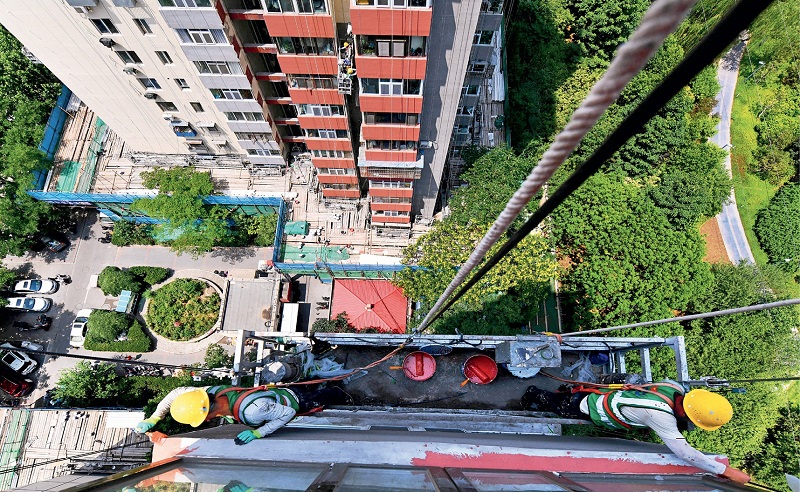During the 14th Five-Year Plan period, a government-led transformation, incorporating resident’s participation, has breathed new life into the capital’s aging neighborhoods.

Construction workers paint exterior walls while suspended mid-air at the renovation site of aging residential buildings in Yangzhuang Central Zone, Shijingshan District, Beijing on June 20, 2023.
Homes in Beijing are being renovated at a rapid rate, especially those in aging residential areas desperately in need of modernization.
Over the past five years, amid a nationwide drive to build livable, resilient, and smart cities, Beijing’s timeworn alleys and aging residential compounds – many built before the year 2000 – have been peeling away their weathered layers in favor of a new look, from revitalized facades to modernized utilities. These buzzing scenes of renewal aren’t only transforming the capital through brick and mortar, but also improving the lives of residents in a revitalization drive that has been prominent throughout the 14th Five-Year Plan period.
Early 2021 saw the official release of the Outline of the 14th Five-Year Plan (2021–2025) for National Economic and Social Development and Long-Range Objectives through the Year 2035. This foundational document charting China’s future included, for the first time, seven metrics focused on people’s welfare among key socioeconomic development indicators.
Provisions like “advancing equal access to public services” and “improving living conditions” became the overarching people-centered ethos throughout the process.
Simultaneously, Beijing responded swiftly through its own operational guide – the Beijing Municipal Plan for Renovation of Old Residential Areas during the 14th Five-Year Plan Period. In 2022, five municipal departments jointly issued regulations to concentrate policy on a “tailor-made design per household” approach. Design teams were charged to conduct home-to-home inspections to customize solutions addressing details such as replacing aging water pipes and exterior insulation.
The results were impressive. According to the Ministry of Housing and Urban-Rural Development, by the end of 2024, over 280,000 aging residential compounds had been renovated across the country, benefiting 48 million households. As a pioneering city in this initiative, Beijing alone spearheaded the transformation of hundreds of communities during 2021-2022 – from elevator retrofits to establishing community care centers, and installing intelligent security systems.
The five-year plan has never been merely a yardstick for economic growth. As aging residential compounds in the capital upgrade fading walls, and age-friendly steps replace waterlogged potholes, the grand narrative of a national plan ultimately materializes brick by brick at the doorsteps of ordinary citizens.

The old Moshikou Street near She Wei’s home has been renovated and transformed into a pedestrian street with modern vibes.
Residential Complexes Get a Facelift
Under the summer heat, sunlight streams into the fifth-floor home of She Wei in Moshikou Xili, Shijingshan District of Beijing, where hallways once clogged with decades of dust have finally been renewed. As a new Beijinger, he purchased this 65-square-meter, two-bedroom apartment – built in 1999 – in 2019. Back then, tangled electrical wires were exposed on walls plastered with ads, while uneven roads pooled with rainwater after every downpour. It was a scene emblematic of the city’s aging residential housing units.
In June 2022, as Beijing’s Shijingshan District accelerated its renovation campaign, She Wei’s community underwent a metamorphic rebirth. Government-funded renovation teams moved in. Like physicians, they performed comprehensive upgrades: repainting exteriors, replacing outdated wiring, renewing kitchen and bathroom plumbing, and repaving roads with fresh asphalt.
Across Beijing, residential complexes built in the 1980s and 1990s stand as witnesses to urban development, yet there were many daily grievances: cracked walls, corroded pipes, chaotic parking, and absent elevators.
As is the norm, the renovation requires signed consent from the majority of homeowners. At She Wei’s compound, community staff and project managers visited each household to secure approvals – renovations for any building unit hinged on reaching a two-thirds agreement threshold.
Initially, She Wei withheld consent, halting upgrades in his unit. As the renovation went underway in neighboring units, many in his unit complained about his non-cooperation.
“We’d freshly renovated our home,” he explained. “Approving the overhaul meant dismantling our floors to replace building-wide plumbing. Though free retiling was offered, the color palettes clashed with our own design. Besides, with a toddler at home, months of construction noise and strangers in our home would disrupt our daily life.”
But for elderly neighbors residing in the complex for decades, self-funded renovations were unaffordable and stressful. They yearned for the government-led transformation.
After repeated mediation by community staff and neighbors, She Wei finally gave in and signed the agreement. “After I got to know the expectations of the elderly neighbors, my wife and I decided to take a step back [and agree].” Within two months, temporary washrooms and water stations were built downstairs. Construction teams efficiently upgraded plumbing systems and communal facilities.
“Almost 30 years [of living] here, and now [we have] such orderliness at our doorstep – what a surprise!” exclaimed She Wei’s downstairs neighbor.
On January 10 this year, at a press briefing for the Guidelines on Public Services in the 14th Five-Year Plan Period, it was noted that during the 14th Five-Year Plan period, China plans to finance the complete renovations of approximately 219,000 urban residential compounds built prior to 2000.
Later in May, Guidelines on Advancing Urban Renewal by the General Offices of the CPC Central Committee and State Council was released, prioritizing upgrades to aging gas pipelines, renovating interior corridors and ventilation shafts, to eliminate safety hazards.
Additionally, to assist with financial terms for people wanting to buy renovated houses, Beijing introduced supportive provident fund policies effective since April 17. Homebuyers purchasing renovated condos can now secure loans with terms extended by 10 to 20 additional years, alleviating pressure caused by shorter loan repayment period for older properties.

The comprehensive renovation projects for aging residential communities in Beijing's Tongzhou District, encompassing 83 buildings in 19 residential compounds, has fully entered the construction phase as of May 23, 2024.
Parking Solutions Beneath Overpasses
Beyond renovating buildings and roads within aging compounds, the absence of underground parking facilities – a legacy of their era – forces residents to rely on limited street-level parking. Expanding external infrastructure is thus vital for improving movement on Beijing’s congested streets.
Since 2024, Beijing has launched a three-year initiative to rehabilitate space beneath overpasses. In February 2025, Beijing’s Transportation Commission has spearheaded multi-agency collaboration – engaging urban planning, municipal management, greening authorities, and district governments – to rehabilitate space beneath overpasses. Currently, Haidian District has completed revitalizing the spaces beneath 58 urban-road and highway bridges, as well as five rail transit overpass zones, making them both beautiful and functional.
Haidian repurposed maintenance depots and relocated bus facilities to unlock public parking potential. After the renovation, parking spaces in the areas increased from around 6,000 to over 8,000, tangibly alleviating local residents’ parking challenges.
Stretching over 700 meters across Haidian’s North Third Ring Road, the 28-meter-wide Lianxiang Bridge neighbors Douyin Plaza, the Dazhongsi commercial hub, and multiple residential compounds, facing great traffic pressure.
Now revitalized, its underpass gleams with clearly marked parking signs and vibrant green pedestrian pathways. Smart parking systems stand alongside upgraded lighting, surveillance, and accessibility features. Soon, mobile EV charging poles will be installed.
When elders play chess beside newly added flower planters or vehicles flow smoothly through new left-turn lanes – these seemingly minor scenes reveal urban renewal’s core ethos: precision governance crystallizes in valuing overlooked spaces; urban care manifests in answering human needs.
As one visitor noted on Rednote (Xiaohongshu) App – a lifestyle sharing social media platform – after going past the Lianxiang Bridge: “It looks so spacious and clean under the bridge now. As an international city, this is how Beijing should be functioning!”
Quietly, a governance revolution is turning marginal zones into urban assets, making Beijing a more livable city.